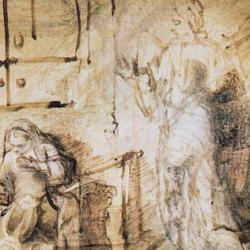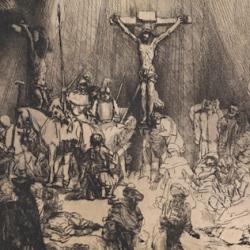Anselm is sometimes accused of deleting the devil from the story of atonement. His satisfaction theory is said to displace and replace the Christus Victor theology of the church fathers, and in so doing to replace and displace Jesus’ conquest of the devil from the center of the atonement.
In fact, this isn’t the case. Anselm repeatedly refers to the devil’s role in derailing the human race, and the need for a human being to overcome the devil to bring human beings to salvation. Several passages from Cur Deus Homo will illustrate.
1)Anselm asks his conversation partner, Boso, to imagine a rich man holding a precious pearl. A malicious person knocks the pearl from his hand into the mud. Would the rich man pick up the muddy pearl and stick it back in his pocked? That would not be wise, Boso says: “surely it would be an appreciably better course to keep and store his pearl clean, rather than dirtied, would it not?” (301).
Anselm draws out the analogy with Adam’s sin: “In the Garden, he used, as it were, to hold man in his hand, destined for fellowship with the angels. He allows the devil, aflame with envy, to stroke him down into the mud, admittedly with man’s consent. For the devil would not have been able to tempt mankind if it had been God’s will to prohibit him. Would God . . . not be acting in a similar way if he were to bring man back to Paradise stained with the filth of sin without any washing, that is, in the absence of any recompense, at least supposing man were to remain in this state forever” (301-2).
This passage doesn’t describe the “mechanism” of atonement, but it does make clear that Anselm believes that humanity will be saved only if the damage done by the devil is undone.
2) Shortly after the first passage, Anselm returns to a discussion of the devil’s temptation in the garden.
“In the Garden, man was created without sin, as if he were placed there as God’s deputy, in a position between God and the devil, the intention being that he might overcome the devil by not consenting when the devil recommended sin by means of persuasion. In the event that man were not to sin despite the devil’s persuasion, this would vindicate and honour God and confound the devil, who, despite his greater strength, committed sin in heaven as a consequence of no one’s persuasion. And although man was easily capable of doing this, he allowed himself to be conquered by persuasion alone, not under forcible compulsion. He did this in accordance with the will of the devil and contrary to the will and honour of God” (307).
Adam, in short, was placed in the garden to “overcome” the devil by obeying God rather than by succumbing to the devil’s temptation. God’s demand on the first Adam is conquest of the devil, Adamus Victor.
Adam of course failed to overcome the devil. If humanity is to be saved, there must be another man who can accomplish what Adam failed to do. This new Adam must, however, accomplish this task not in the strength of innocence but from within the broken condition of postlapsarian humanity.
Anselm writes: “In the same way that man, when he was strong and potentially immortal, easily complied with the devil’s suggestion that he should commit a sin, and hence justly incurred the penalty of becoming mortal, correspondingly, now that he is weak and mortal, being himself responsible for having made himself like this, man needs to conquer the devil through the difficulty of death, and in so doing to sin in no way. He cannot do this, so long as he is conceived by the wound of primal sin, and so long as he is born in sin” (307-8).
Not only is Anselm teaching a form of Christus Victor atonement; he is also dealing in the paradoxical symmetries that so deeply mark patristic atonement theology (e.g., the immortal dies). The analogy is this: Strong, immortal Adam fell to devil; weak, mortal last Adam overcomes the devil.
3) The devil comes up again as Anselm develops sin and atonement in terms of theft and restitution. Adam stole from God, and he cannot be saved unless recompense is made. What did he steal? Anselm answers: “Did he not steal from God whatever he planned to do with regard to the human species?” (308).
What man owes is nothing less than human destiny. That is what the Savior must restore.
Adam stole from God at the instigation of the devil, and so the repayment must involve conquest of the devil. Anselm elaborates: “Subject the matter to strict justice, and judge accordingly whether man may give recompense for his sin to a level commensurate with his sin, if he does not give back, by conquering the devil, what he has stolen from God by allowing himself to be conquered by the devil. Just as, through the fact of man’s defeat, the devil took what belonged to God, and God lost it, so, correspondingly, in the event of man’s victory, the devil would be the loser and God would regain what he had lost” (308).
Thus, from a variety of angles, Anselm incorporates victory over Satan into his satisfaction account of the atonement.












